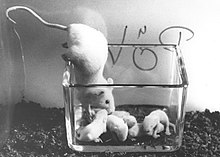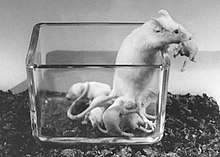Entry behavior


As entry Ever Hold ( Engl. : Retrieving , rarely: retrieval behavior ) is widespread among mammals behavior from the complex of social behavior referred, in which packed a young adult (mostly female) counterparts with the mouth and taken to another location . This can be observed in dogs and cats , guinea pigs and golden hamsters , rats and mice, among others . Even hippos attributed this behavior and also in birds, it was observed. As a rule, the young immediately lapse into a rigidity when they are packed; Golden hamsters occasionally carry their young in their cheek pouches.
The similarity with which the import behavior takes place in all animal species practicing this behavior led the behavioral researchers to conclude that it is undoubtedly innate and has common ancestral roots. It has therefore been intensively researched, and since it can be evoked in experiments at any time (you only have to remove the nestlings of a mother mouse or rat from the nest and place them in another corner of the cage), it found its way into the biology education of various universities and became this is also a popular school experiment. It is now considered to be the best studied maternal behavior of rats and house mice .
While the feeding behavior can easily be induced in caged rodents , it rarely occurs outdoors: namely, especially when the nest of a mouse becomes unusable after rain, for example. The mother then has to build a new nest elsewhere and enter the young animals - one after the other - into the new nest. The same applies to wolves in the wild.
It is noteworthy that many rodents bring strange young of their own species into the nest like their own (i.e. adopt them ) and that they - even in the wild - occasionally even bring nestlings of strange species; There are reports that female rats and even Syrian hamsters “adopted” baby mice, that is, raised their own nestlings. The stimuli or stimulus combinations (see: key stimulus ) that cause the rodents' feeding behavior were therefore referred to as cross-species characteristics : apparently not only people react to a so-called child pattern .
Despite many test arrangements that have been tried out since the early 1950s, these stimuli that trigger the feeding behavior have not yet been clearly deciphered; It is probably the smell, because dead young are often entered like the living ones, so that vocalizations and movements can be excluded as primary stimuli.
See also
literature
- Karl-Heinz Wellmann : On the effect of disruptive selection on the behavior of house mice (Mus musculus domesticus Rutty): entering nestlings, further elements of brood care behavior and exploration . Science publishing house Dr. Wigbert Maraun, Frankfurt am Main 1991, ISBN 3-927548-18-9
- Gianluca Esposito et al .: Infant Calming Responses during Maternal Carrying in Humans and Mice. In: Current Biology. Volume 23, No. 9, 2013, pp. 739-745, doi : 10.1016 / j.cub.2013.03.041
Web links
Individual evidence
- ^ Klaus Immelmann : Dictionary of behavior research. Paul Parey Publishing House, 1982
- ↑ Otto von Frisch : Meadow Harrier (Circus pygargus) brings in boy. In: Zeitschrift für Tierpsychologie. Volume 23, 1966, pp. 581-583.
- ^ GR Witte: Boy transport in the cheek pouches of the Syrian golden hamster (Mesocricetus auratus Waterhouse, 1939). In: Journal of Mammals . Volume 36, 1971, pp. 216-219.
- ↑ Christine Michard, Pierre Roubertoux: Differences of patterns in pup care in Mus musculus: VI. Uses of segregating generations to dissociate behavioral units in retrieving. In: Journal of Comparative Psychology. Volume 100, 1986, pp. 285-290.
- ^ Warren G. Holmes, Paul W. Sherman: Kin recognition in animals. In: American Scientist. Volume 71, 1983, pp. 46-55.
- ↑ Hans-Joachim Bischof : The brood care behavior of laboratory rats (Rattus norvegicus f. Domestica). In: AW Stokes et al .: Practical course in behavioral research. G. Fischer Verlag, Stuttgart 1978.
- ↑ Gerti Dücker et al .: Studies on the duration of continuous feeding behavior in mice. In: Behavior. Volume 77, 1981, pp. 77-98.
- ^ Samuel Anthony Barnett: The rat. A study in behavior. University of Chicago Press, 1975.
- ↑ a b Irenäus Eibl-Eibesfeldt : The behavior of rodents. In: Handbook of Zoology. Volume 8, 10 (13), 1958, pp. 1-88.
- ↑ Irenäus Eibl-Eibesfeldt: Contributions to the biology of the house mouse and the ear mouse, together with some observations on other rodents. In: Zeitschrift für Tierpsychologie. Volume 7, 1950, pp. 558-587.
- ^ Fritz Frank: Adoption attempts in field mice (Microtus arvalis Pall.). In the journal of animal psychology. Volume 9, No. 3, 1952, pp. 415-423, doi: 10.1111 / j.1439-0310.1952.tb01662.x
- ^ Frank A. Beach , Julian Jaynes : Studies of maternal retrieving in rats. III. Sensory cues involved in the lactating female's response to her young. In: Behavior. Volume 10, 1956, pp. 104-125.
